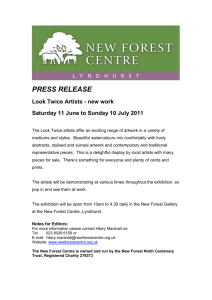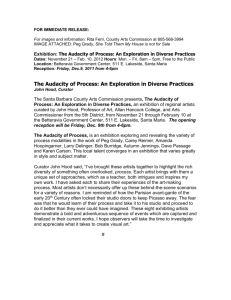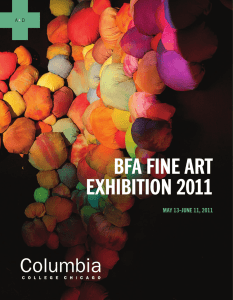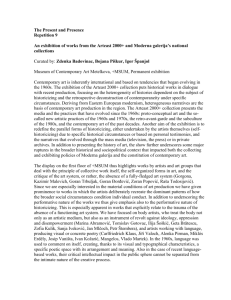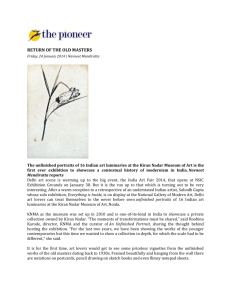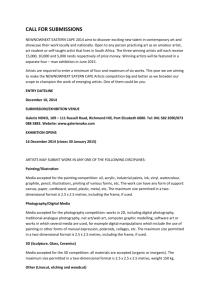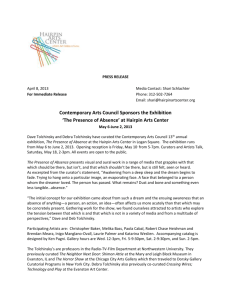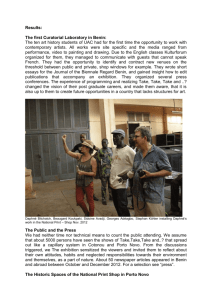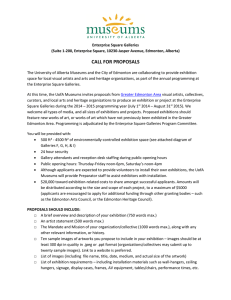Path of Resistance Brochure text - Dark Matter Archives – Gregory
advertisement
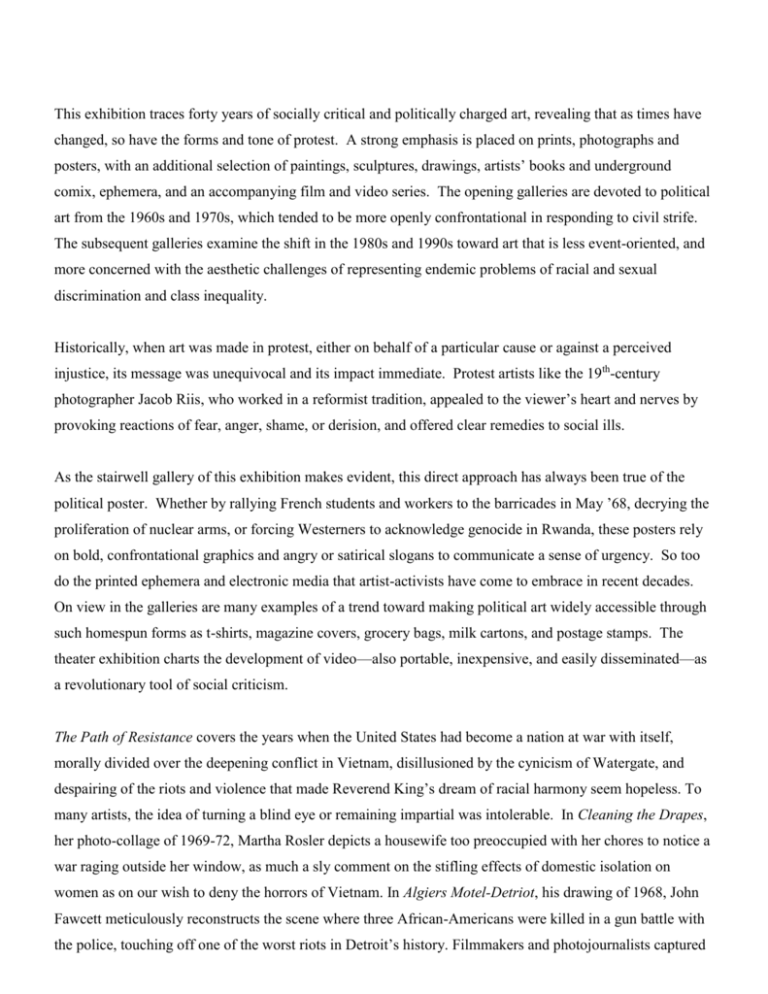
This exhibition traces forty years of socially critical and politically charged art, revealing that as times have changed, so have the forms and tone of protest. A strong emphasis is placed on prints, photographs and posters, with an additional selection of paintings, sculptures, drawings, artists’ books and underground comix, ephemera, and an accompanying film and video series. The opening galleries are devoted to political art from the 1960s and 1970s, which tended to be more openly confrontational in responding to civil strife. The subsequent galleries examine the shift in the 1980s and 1990s toward art that is less event-oriented, and more concerned with the aesthetic challenges of representing endemic problems of racial and sexual discrimination and class inequality. Historically, when art was made in protest, either on behalf of a particular cause or against a perceived injustice, its message was unequivocal and its impact immediate. Protest artists like the 19th-century photographer Jacob Riis, who worked in a reformist tradition, appealed to the viewer’s heart and nerves by provoking reactions of fear, anger, shame, or derision, and offered clear remedies to social ills. As the stairwell gallery of this exhibition makes evident, this direct approach has always been true of the political poster. Whether by rallying French students and workers to the barricades in May ’68, decrying the proliferation of nuclear arms, or forcing Westerners to acknowledge genocide in Rwanda, these posters rely on bold, confrontational graphics and angry or satirical slogans to communicate a sense of urgency. So too do the printed ephemera and electronic media that artist-activists have come to embrace in recent decades. On view in the galleries are many examples of a trend toward making political art widely accessible through such homespun forms as t-shirts, magazine covers, grocery bags, milk cartons, and postage stamps. The theater exhibition charts the development of video—also portable, inexpensive, and easily disseminated—as a revolutionary tool of social criticism. The Path of Resistance covers the years when the United States had become a nation at war with itself, morally divided over the deepening conflict in Vietnam, disillusioned by the cynicism of Watergate, and despairing of the riots and violence that made Reverend King’s dream of racial harmony seem hopeless. To many artists, the idea of turning a blind eye or remaining impartial was intolerable. In Cleaning the Drapes, her photo-collage of 1969-72, Martha Rosler depicts a housewife too preoccupied with her chores to notice a war raging outside her window, as much a sly comment on the stifling effects of domestic isolation on women as on our wish to deny the horrors of Vietnam. In Algiers Motel-Detriot, his drawing of 1968, John Fawcett meticulously reconstructs the scene where three African-Americans were killed in a gun battle with the police, touching off one of the worst riots in Detroit’s history. Filmmakers and photojournalists captured 2 vivid images of antiwar demonstrations and women’s and gay liberation marches, and bore witness to the massacres at Kent State and My Lai. Andy Warhol joined the political fray by helping to raise funds for George McGovern’s 1972 presidential campaign through sales of his wickedly lurid silkscreen portrait of the Senator’s opponent, Richard M. Nixon. The photographers Robert Frank, Diane Arbus, and Garry Winogrand, who were less concerned with taking sides, were nonetheless drawn to the drama of public confrontation. Even Ad Reinhardt, a painter normally accustomed to the detached, self-referential purity of Abstract Expressionism, was moved to contribute to a portfolio of prints done in 1967 in protest against the war in Vietnam. Political art of the 1960s and 1970s tended to be aesthetically accessible and readily understandable. This is partly because artists addressed stark events that lent themselves well to visual representation—cops turning dogs on blacks in Birmingham, or the torture of Cambodians in Khmer Rouge prisons—and took on causes for which there was the prospect of specific legal resolution, such as desegregation and equal rights. By the 1980s, the popularity of street protest had waned, and some of the most overt forms of institutionalized discrimination had vanished. What still persisted, however, were the painful and difficult realities of bigotry and intolerance, so abstract in nature as to elude literal interpretation and so deeply ingrained in our culture and history as to defy clear solutions. Recognizing this, the more successful political artists of the last two decades have confronted these seemingly intractable, endemic problems by complicating rather than simplifying our understanding of them. Felix Gonzalez-Torres, an openly gay artist of Hispanic descent who died of AIDS, created works that entice viewers with their seductive beauty and engage them in multiple, elusive meanings. Though the seven paper cones of his “Untitled” (Supreme Majority) (1991) seem at first glance to belong to the rarefied world of Minimalist abstraction, on closer examination they resemble dunce caps, or the spiked peaks and valleys of opinion polls. As the title suggests, the cones can thus be seen as an oblique rebuke to the demagogy of the recent political landscape, or an allusion to the seven Supreme Court justices appointed by Reagan and Bush. In the contemporary climate of hostility towards feminism, the photographer Laurie Simmons uses surreal humor to take hold of the viewer. Her Walking House of 1989 is a send-up of 1940s ads of dancing cigarette boxes, or a throwback to the 1950s housewife. Sue Coe’s graphic painting Woman Walks into Bar—is Raped by 4 men on the pool table—while twenty watch (1983) does not simply evoke a brutal event, but rather implicates the gallery viewer as a voyeur and suggests that all too often we stand by passively when sexual violence occurs. Cindy Sherman abandons her characteristic playfulness in Untitled #188 (1989), a 3 photograph grotesquely staged to depict what seems to be the aftermath of a rape, its victim a twisted blowup sex-doll left lying amid the detritus of a wild party. Numerous recent artists have explored the way culture constructs racial identity, frequently by evoking the way that America’s racist past has deformed it. In Melvin Edwards’s Lynch Fragment series (1986-89), four mounted steel sculptures gnarled to resemble torture instruments are a bitter reminder of Southern vigilantism. One cannot help but think the same of David Hammons’s Money Tree (1992), a Sepiaprint of a tree with a metal ring embedded in it, even though it simultaneously connotes the elusive hoop dreams of young African-Americans. In her haunting series From Here I Saw What Happened and I Cried (1995), Carrie Mae Weems appropriates daguerrotypes of slaves and other old photographs and superimposes her own captions over them, calling attention to their racial stereotyping and inviting us to consider our own prejudices. Kara Walker’s manner of depicting antebellum scenes in her 1997 etched glass canisters and prints is an unsettling blend of sexual rawness, violence, and, at times, subversive humor. And Glenn Ligon’s Untitled (How it feels to be colored me…Doubled) (1991), in which the stenciled words of Zora Neale Hurston are gradually obliterated, is a powerful metaphor for how the black voice has been historically silenced in white America. Looking back on a corrosive past, these artists—and many of the others whose works conclude this exhibition—forecast a less than reassuring future. From the exhibition: "The Path of Resistance. MoMA meets Moderna 1960 – 2000," Held at the Museum of Modern Art, NYC 2001-05-19 until 2001-08-26
